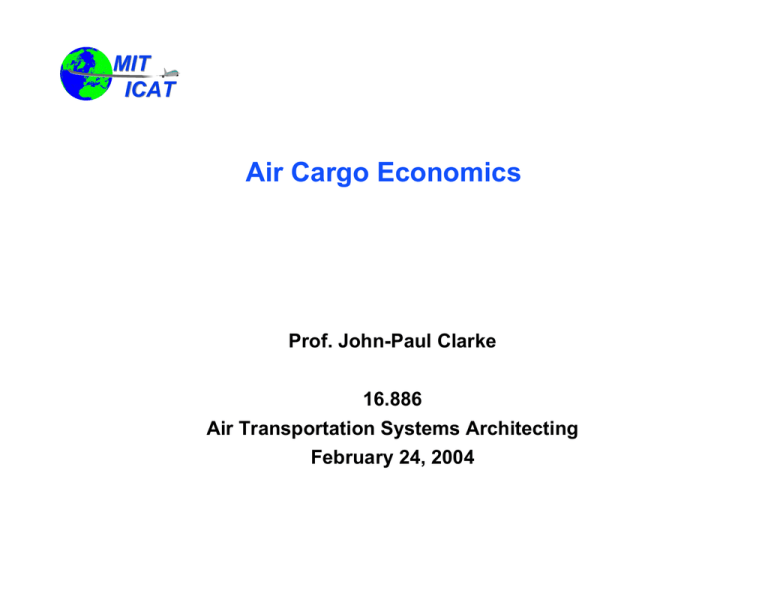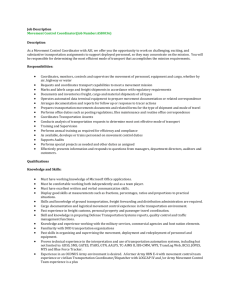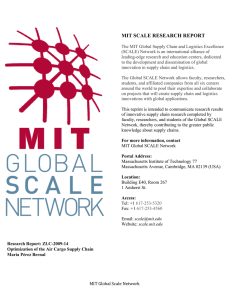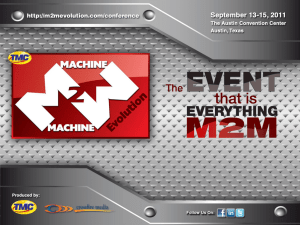Air Cargo Economics MIT ICAT Prof. John-Paul Clarke
advertisement

MIT ICAT Air Cargo Economics Prof. John-Paul Clarke 16.886 Air Transportation Systems Architecting February 24, 2004 MIT ICAT • Lecture Outline Air Cargo Industry – Types of air cargo and air cargo carriers – Largest air cargo carriers • Demand for Air Cargo Services – Drivers of air cargo growth – Constraints on growth • Recent Trends in Air Cargo – Traffic and tariffs – Industry structure – Impacts of recent recession and 9/11 • Breakdown of Cargo Revenue and Cost MIT ICAT Air Cargo Industry • Air Cargo Categories – Express/time definite: small packages (less than 100 lb.) – Heavyweight freight shipments (greater than 100 lb.) – Mail transport Participants: • All-Cargo Airlines – Integrated Express Carriers (express/small packages; door to door service) – Non-integrated Freight Carriers (heavyweight freight shipments; work with freight forwarders, etc.) • Passenger (Combination) Airlines – Can carry air freight, express packages and mail in passenger aircraft belly or on “combi” aircraft – Also can have dedicated freight aircraft MIT ICAT Top Air Cargo Airlines Worldwide in 2000 Total Freight and Mail (Int’l + Domestic) Carrier Ton-miles (millions) 1. Federal Express 7,466 2. Lufthansa German Airlines 4,995 3. Singapore Airlines 4,188 4. Korean Air 3,873 5. Air France 3,553 6. Japan Air Lines 3,226 7. United Airlines 3,153 8. KLM Royal Dutch Airlines 2,969 Source: Aviation and Aerospace Almanac 2002 MIT ICAT Top U.S. Air Cargo Airlines in 2001 Total Freight and Mail (Int’l + Domestic) Carrier Ton-miles (millions) 1. Federal Express 7,565 2. UPS Airlines 4,081 3. United Airlines 1,919 4. Northwest Airlines 1,918 5. American Airlines 1,813 6. Delta Airlines 1,269 7. Atlas Air 1,072 8. Polar Air Cargo Source: ATA Annual Report 2002 892 MIT ICAT Selected Cargo Carriers 2001 (Source: ATA) Carrier Number of Aircraft Air Cargo Ton-miles (millions) Cargo Revenue ($ million) % of Operating Revenue FedEx 320 7,609 $ 6,948 45.8 % UPS Air 258 4,094 $ 2,624 96.6 % United 543 2,390 $ 704 4.3 % Northwest 440 2,161 $ 715 7.5 % KLM 132 2,512 $ 882 15.5 % MIT ICAT Demand for Air Cargo Services • Like demand for passenger air travel, demand for air cargo shipment is a “derived” demand. • Primary drivers of air cargo demand include: – Economic growth and trade (especially imports/exports) – Relative prices of air cargo versus alternatives – ocean, truck, rail • Difficult to quantify demand/supply accurately: – No comprehensive sources of data on air cargo traffic and pricing – Lack of published schedule data (unlike passenger airlines) – Vertically integrated air cargo operators (like Fedex and UPS) only publish limited schedules for selected flights – All-cargo carriers tend to operate flexibly based on daily/weekly demands – Combination carriers provide joint supply of cargo and passenger capacity MIT ICAT Drivers of Air Cargo Growth in 1990s • Overall economic growth (especially world trade) – Historically, 2 to 2.5% increase in world trade with each 1% increase in total GDP – Air freight trade has been growing even faster, due to regional differences in economic growth – Since 1993, average 7-10% annual growth in world air freight traffic • Globalization – Increasingly integrated and interdependent national economies – Liberalized (free) trade and reduced protectionism • Lean Inventory Strategies – Reduced order-cycle times: “just in time” and “make to order” – Less stock on hand to avoid production shutdowns, retail stockouts – Air freight shortens delivery times to customer MIT ICAT Constraints on Air Cargo Growth • Economic recession – Reduced production, demand for goods, international trade • Trade barriers – Tariffs or protectionism designed to limit free trade • Aircraft regulations – Air cargo operators have used older aircraft that are most affected by new regulations on noise, emissions and safety – For example, noise hush-kits reduce cargo payloads • Modal competition – Air freight has tremendous speed advantage for long distances, but is highest-cost option – Trucks very competitive for short haul (1000 miles, overnight) – Development of new “fast ships” for ocean cargo MIT ICAT Recent Trends in Air Cargo • Rapid growth in demand for air cargo – Intra-Asia is the largest true air freight market – Even during Asian economic crisis air freight traffic grew – Forecasts for continued traffic growth at 6% per year • Falling real yields (revenue per ton-mile) – Average 2.5% decline in yields (CPI adjusted) – Growth in international trade has increased trip length, associated with lower tariffs per mile – Wide-body aircraft have unused belly capacity, viewed by passenger airlines as virtually “costless” • Passenger airlines have become price leaders in air freight – Regulatory liberalization has spurred price competition • Lower tariffs further stimulate demand, but also cause airlines to focus on lowering unit costs MIT ICAT Trends in Air Cargo (cont’d) • Integrator expansion – Integrated express carriers own air and ground assets to handle entire shipment journey – Fedex and UPS, facing competition and decreasing yields in express documents, expanded to international markets – With limited international small package growth, carry standard air freight (airport to airport) as “filler” – Trying to develop products for higher-yield industrial traffic • Consolidation of freight forwarders – Non-integrated carriers receive majority of traffic from freight forwarders – FFs handle retail marketing and pick-up/delivery – Number of mid-sized freight forwarders has been shrinking, leaving largest operators and niche competitors MIT ICAT Air Cargo Outlook (Source: Al Haggerty) • Global AIRLINE PAX TRAFFIC forecast to grow @ 4.5% per year between 1999 and 2010 • Global AIR FREIGHT forecast to grow @ 6.0% per year between 1999 and 2010 • ASIA-PACIFIC REGION expected to dominate air freight market • UNIT COSTS declined at an average annual rate of 3.0% between 1960 and 1999 • Larger, more efficient freighters are making air freight more competitive MIT ICAT Operating Profit (Domestic Cargo Carriers) Operating Profit Margin, Year 2000 8 Operating Profit Margin (%) 6 4 2 0 DHL -2 -4 -6 Fedex UPS Passenger Majors MIT ICAT Load Factors (Domestic Cargo Carriers) Ton Load Factor for Scheduled Cargo Service 64 62 Ton Load Factor (%) 60 58 56 54 52 50 DHL Fedex UPS MIT 727-200 Hourly Operating Cost Breakdown, ICAT Q1 2001 Burden 10% Other 1% Crew 28% Maintenance 14% Taxes 3% Insurance 0% Depreciation 10% Rentals 1% Fuel/Oil 33% Estimated from data for passenger aircraft MIT 757-200 Hourly Operating Cost Breakdown, ICAT Q1 2001 Burden 9% Other 1% Crew 24% Maintenance 14% Taxes 2% Insurance 0% Depreciation 7% Rentals 15% Fuel/Oil 28% Estimated from data for passenger aircraft MIT 767-200 Hourly Operating Cost Breakdown, ICAT Q1 2001 Burden 10% Other 3% Crew 26% Maintenance 18% Taxes 2% Insurance 0% Depreciation 7% Rentals 3% Fuel/Oil 31% Estimated from data for passenger aircraft MIT 767-300 Hourly Operating Cost Breakdown, ICAT Q1 2001 Burden 9% Insurance 0% Taxes 2% Other 1% Crew 28% Maintenance 8% Depreciation 5% Rentals 13% Fuel/Oil 34% Estimated from data for passenger aircraft MIT DC-10-30 Hourly Operating Cost Breakdown, ICAT Q1 2001 Burden 9% Other 1% Crew 15% Maintenance 25% Fuel/Oil 34% Taxes 1% Insurance 0% Depreciation 9% Rentals 6% Estimated from data for passenger aircraft MIT ICAT MD-11 Hourly Operating Cost Breakdown, Q1 2001 Burden Other 1% 7% Taxes 2% Maintenance 12% Crew 22% Insurance 0% Depreciation 10% Rentals 12% Fuel/Oil 34% Estimated from data for passenger aircraft MIT 747-200 Hourly Operating Cost Breakdown, ICAT Q1 2001 Other 1% Burden 20% Crew 18% Maintenance Taxes 15% 1% Insurance 0% Depreciation 4% Rentals Fuel/Oil 34% 7% Estimated from data for passenger aircraft MIT 747-400 Hourly Operating Cost Breakdown, ICAT Q1 2001 Burden 10% Maintenance 10% Taxes 1% Other 1% Crew 24% Insurance 0% Depreciation 5% Rentals 15% Fuel/Oil 34% Estimated from data for passenger aircraft MIT ICAT Number of Aircraft (Narrow Body) • Payload less than 60,000 lbs – – – – 727-100 727-200 737-200/300 Bae 146 – DC-9 215 283 35 25 104 • Payload between 60,000 & 120,000 lbs (narrow body) – – – – 707-320 757-200 DC-8-50/60 DC-8-70 55 80 103 103 MIT ICAT Number of Aircraft (Wide Body) • Payload between 70,000 & 140,000 lbs (wide body) – – – – A300-B4 A300-600 A310-200 767-200 67 45 41 16 – 767-300 – DC-10-10 16 40 – MD-10-10 – L-1011 1 11 MIT ICAT Number of Aircraft (Wide Body) • Payload more than 140,000 lbs – – – – 747-100 747-200 747-300 747-400 30 137 4 50 – DC-10-30 – DC-10-40 51 3 – MD-10-30 – MD-11 1 77 MIT ICAT Key Questions • Where can an air cargo carrier reduce cost? • If you could automate aircraft operations, which aircraft type would give you the best leverage? • Is there any specific segment of the air cargo market that is primed for growth? • How would you “grow” this market segment?




